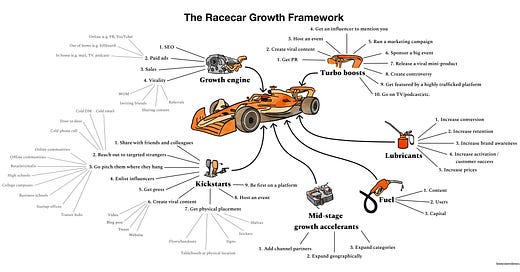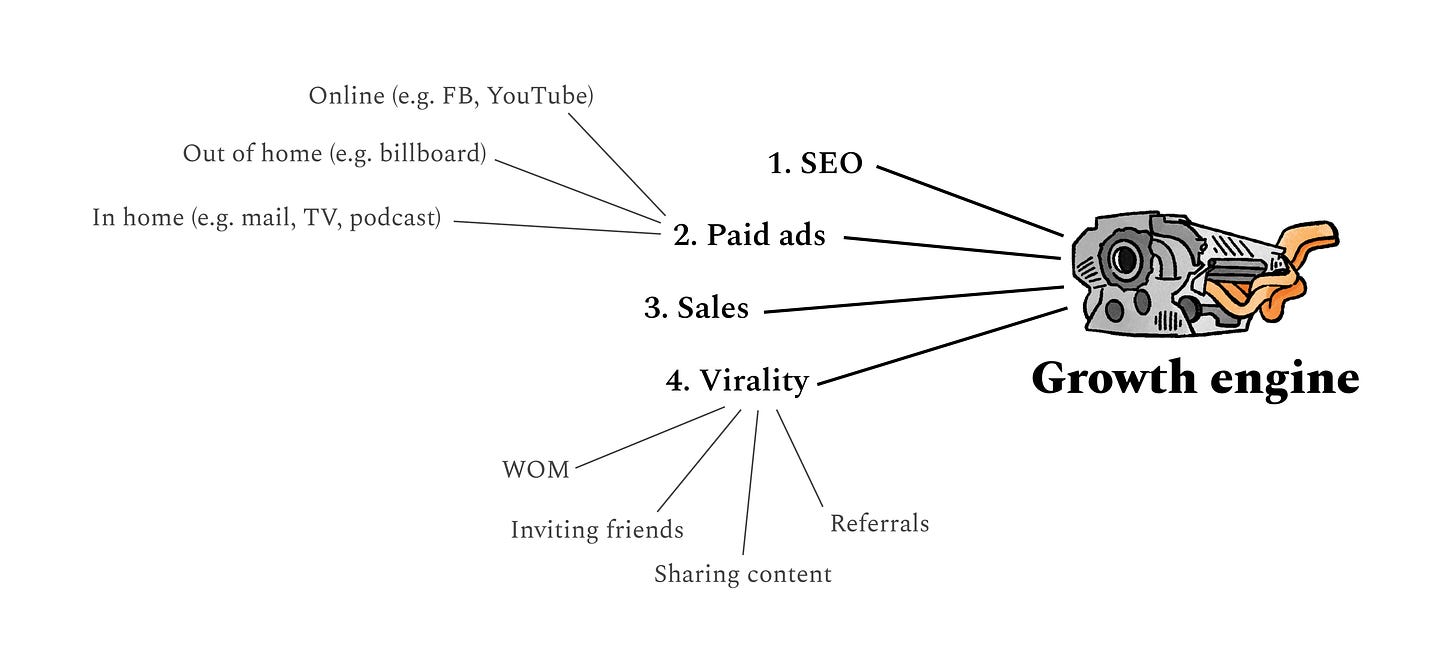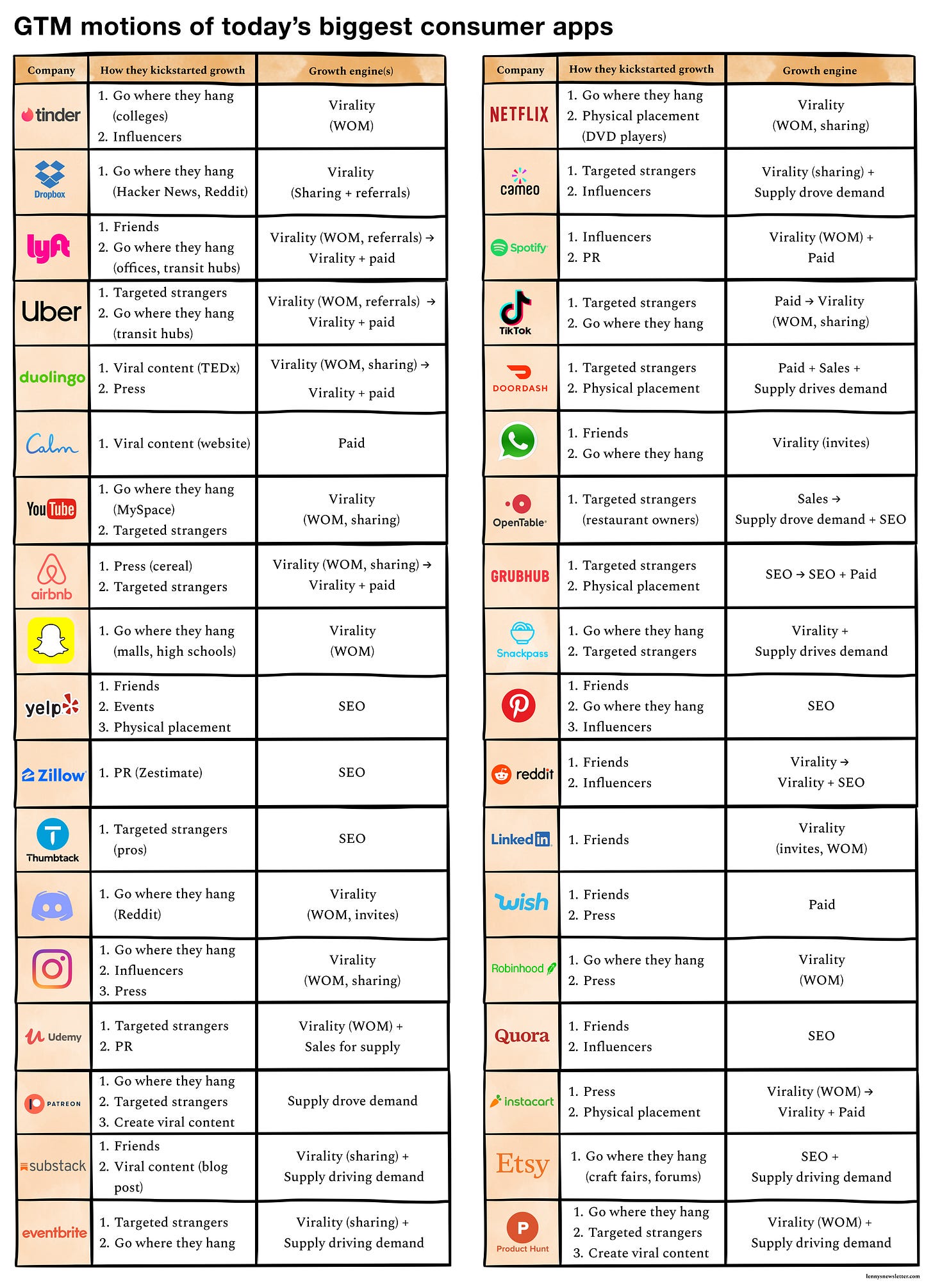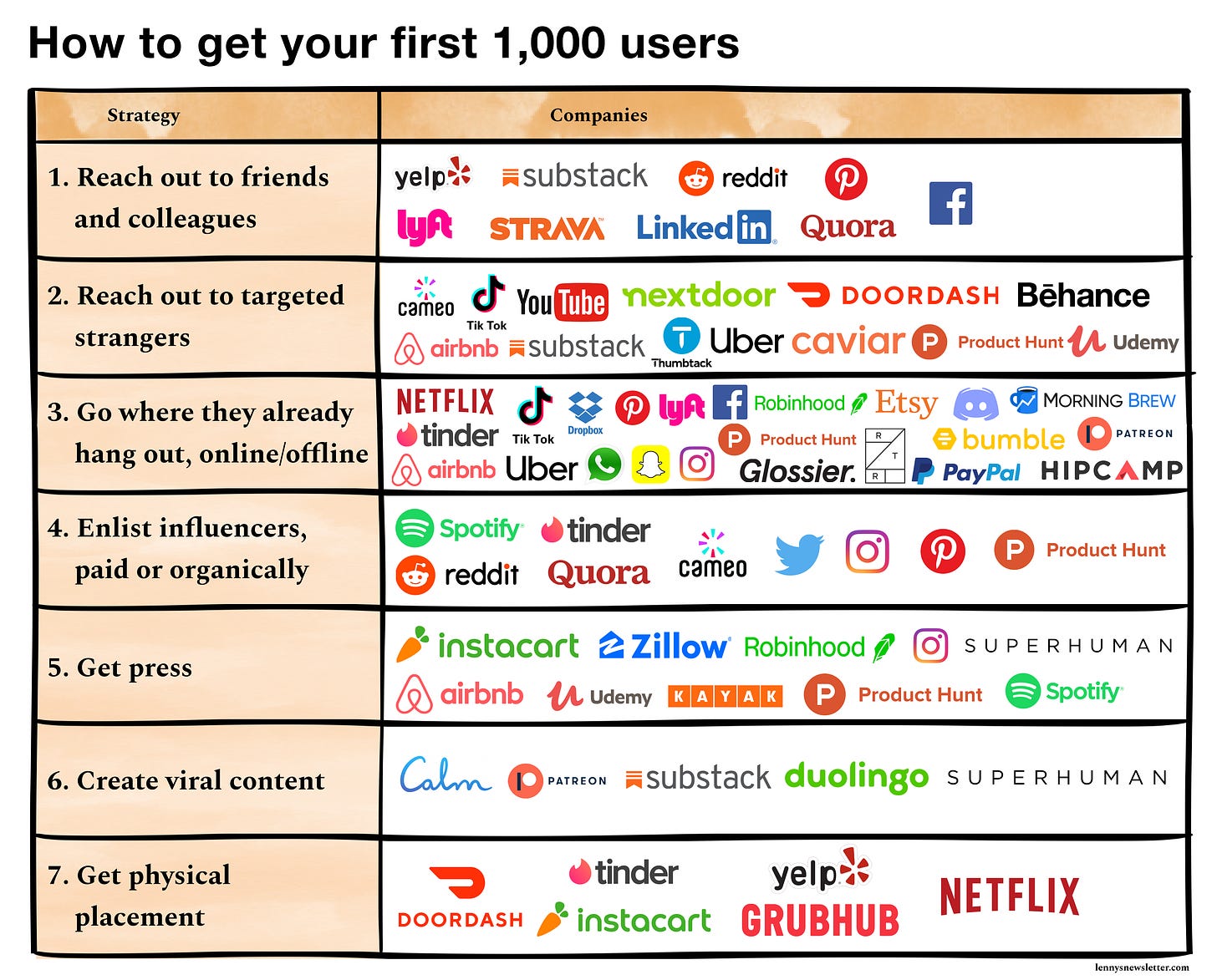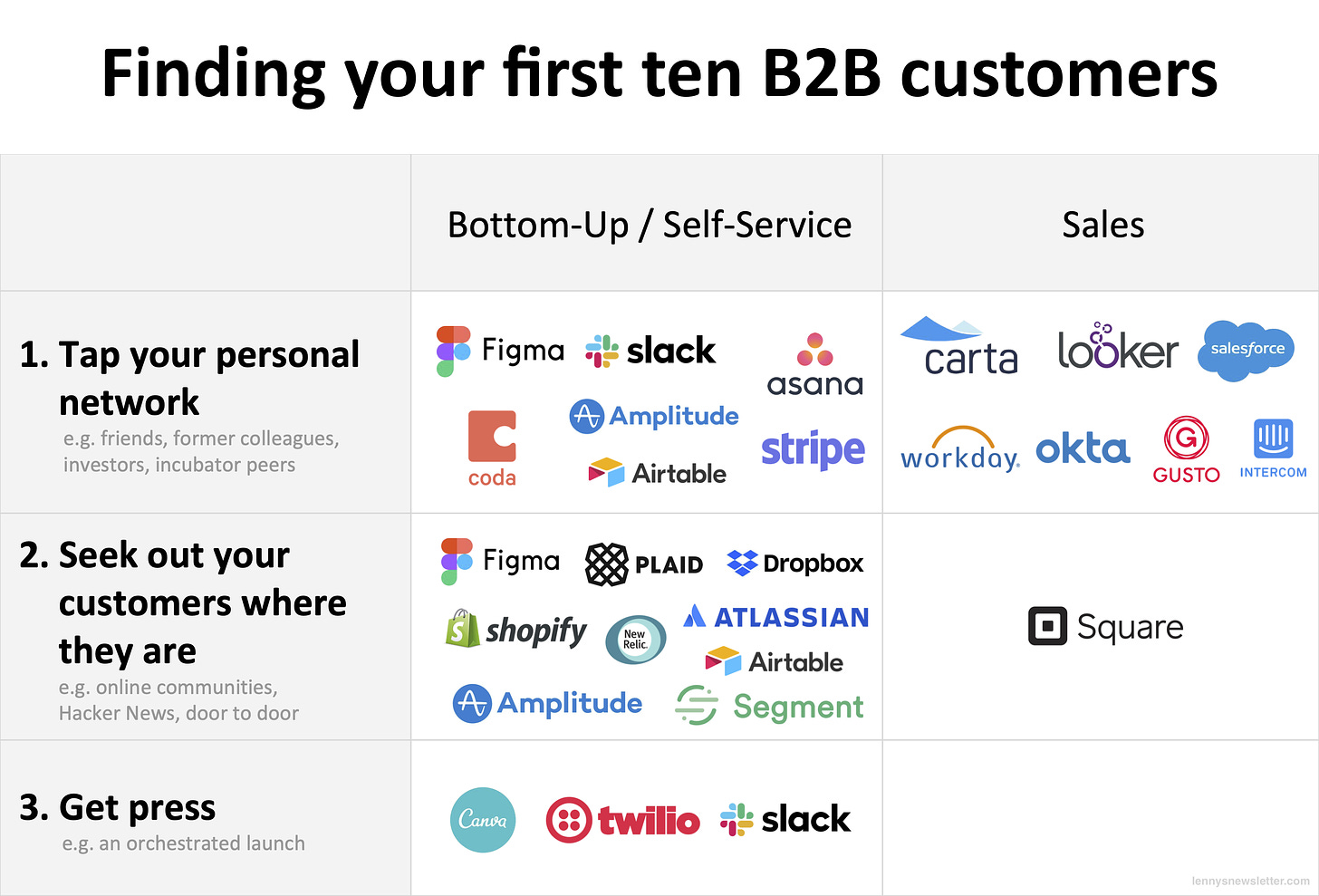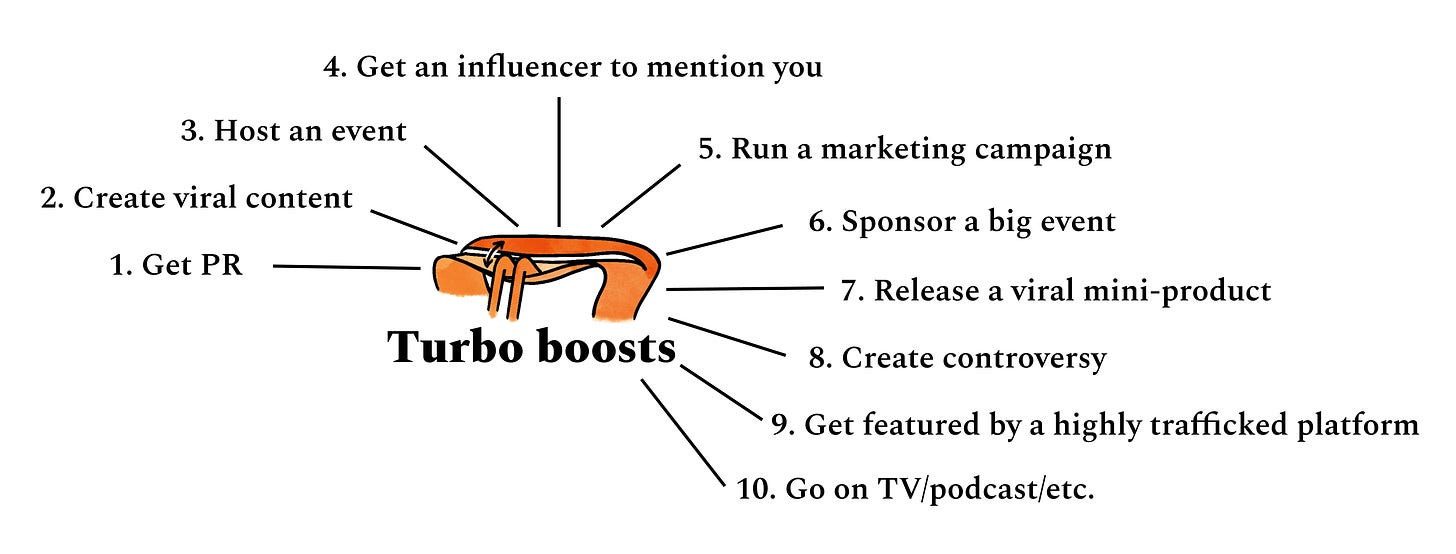The Racecar Growth Framework—expanded and illustrated
The culmination of all my GTM and growth research in one image
👋 Hey, I’m Lenny and welcome to a 🔒 subscriber-only edition 🔒 of my weekly newsletter. Each week I tackle reader questions about product, growth, working with humans, and anything else that’s stressing you out about work.
Q: Can you go one level deeper on the Racecar Growth Framework—how do I actually use it in practice?
All my research into GTM and growth strategy can be summarized in this one (hot-off-the-press) image:
This image includes not just the components of how your startup grows, but also the most popular tactics within each component. I encourage you to use this as a source of inspiration for your growth ideation. When you’re developing a new growth strategy, or struggling to come up with tactical ideas, start here.
Below, I’ll expand on each component and associated tactics, and share some advice for how to use this framework. Generally, here’s when to focus on each component:
When you’re just starting out, focus your energy on Kickstarts, and maybe a few Turbo boosts, until your Growth engine begins to drive the majority of your growth. Here’s a template to help you plan your GTM.
Once you have a working Growth engine, invest in Lubricants to help it run more efficiently, and the occasional Turbo boost to boost growth.
Once you’re at a meaningful scale, explore one or two Mid-stage accelerants.
Before your primary engine asymptotes, experiment with and kickstart an additional Growth engine, while continuing to Lubricate your existing growth engine(s).
[Future posts] To continue growing, layer on an additional business unit, expand to new segments (e.g. enterprise), and grow within existing accounts (e.g. increase NRR).
A huge thank-you to Dan Hockenmaier (recent podcast guest!) for partnering with me on initially developing this framework and for continuing to help me refine it. This post will be a living document, where I’ll add to it as I learn of new and effective tactics.
Please leave a comment and let me know what I might be missing or have wrong 👇
The Racecar Growth Framework—Expanded
1. The Growth Engine
The growth engine is a self-sustaining growth loop that drives nearly all your growth long-term. Of all the components, the growth engine is the most important because it’s the only component that can be self-sustaining—creating an output (e.g. revenue) that can then be reinvested into more growth (e.g. ads).
There are four common growth engines:
SEO: You (or your users) create content → People discover your content while searching (e.g. Google, YouTube, TikTok, etc.) → They become users → More users leads to more content
Paid ads: You run ads online (e.g. FB, AdWords, YouTube), OOH (e.g. billboards, buses), or in-home (e.g. direct mail, TV, podcasts) → Ads drive users → Users generate revenue → Revenue is used to run more ads
Sales: You hire salespeople → Salespeople get customers → Customers drive revenue → Revenue is used to hire more salespeople
Virality: User signs up → User enjoys product and shares product with other people (either through word of mouth, inviting their friends through your product, sharing content from the app, or incentivized referrals) → Friend signs up and shares it with their friends
Here’s an overview of the growth engines behind today’s biggest consumer apps (second column):
Here are the primary growth engines of today’s biggest B2B products (second column)—essentially it’s always sales, though some products have a product-led (aka self-service) element:
P.S. In the B2C list, you’ll notice there’s one additional growth engine, “Supply driving demand.” This can be thought of as a growth engine, and an incredibly powerful one at that, but it won’t be the source of your growth, because you still need to grow the supply in the first place (usually through sales), so I don’t spend a lot of time on it. Read more about this engine here.
2. Kickstarts
Kickstarts are unscalable tactics for acquiring your first 1,000 users. The nine most common (and effective) kickstarts, including links to examples of each in action:
Go pitch your target audience where they hang out
Online communities (e.g. Dropbox and HackerNews, Discord and Reddit, Netflix and niche forums)
Offline communities (e.g. Etsy and craft fairs)
Retailers/malls (e.g. Hipcamp and REI, Pinterest and Apple stores, Snapchat and malls)
High schools (e.g. Snapchat)
College campuses (e.g. Tinder)
Business schools (e.g. Morning Brew)
Startup offices (e.g. Lyft, Wealthfront)
Transit hubs (e.g. Uber and CalTrans station)
Paid
Organically fans
Blog post (e.g. Superhuman)
Video (e.g. Duolingo)
One-off website (e.g. Calm)
Tweet
In B2C you have many options, but in B2B you really only have three: friends and colleagues; go pitch them where they hang; and press.
Here’s an overview of which products relied on which kickstarts in B2C:
3. Turbo boosts
Turbo boosts are one-off events that accelerate growth temporarily but don’t last. There’s some overlap here with kickstarts, but the difference is that kickstarts are effective for getting you started (e.g. unscalable, scrappy, low investment), while turbo boosts can accelerate growth at any point.


